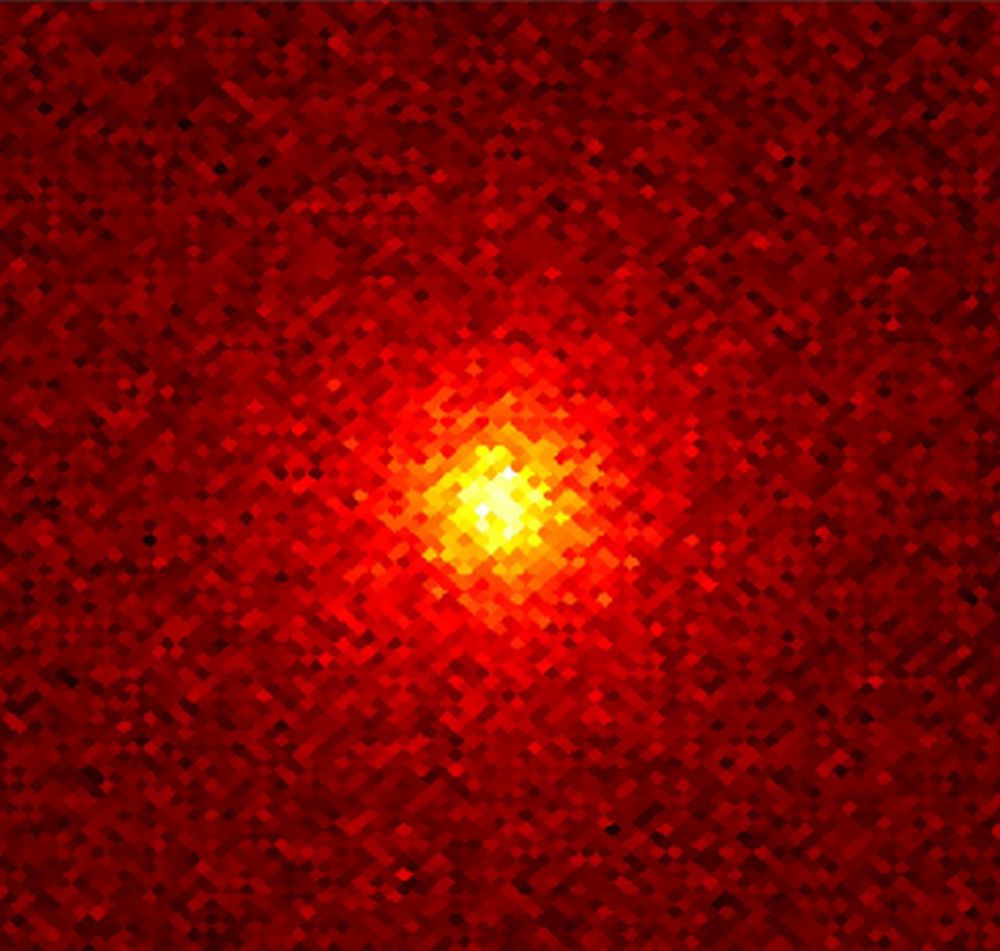The eerie, hellish glow coming from the Moon may seem unreal in this image, since it’s invisible to our eyes. But instruments that detect gamma rays tell us it’s real. More than just a grainy, red picture, it’s a vivid reminder that there’s more going on than meets human eyes.
It’s also a reminder that any humans that visit the Moon need to be protected from this high-energy radiation.
From Cosmic Rays to Gamma Rays
NASA’s Fermi Gamma-Ray Space Telescope captured these images of the Moon’s gamma rays. In this part of the electromagnetic spectrum, the Moon is actually brighter than the Sun. That’s because the Sun produces most of its energy in other parts of the spectrum, though it does emit some gamma rays, especially during solar flares.
Most gamma rays in our Solar System come from distant sources like quasars and active galactic nuclei (AGN.) The Moon is an indirect source of gamma radiation, and produces gamma rays through its interaction with cosmic rays.
Cosmic rays are a type of high-energy radiation that for the most part is produced outside our Solar System. They’re produced by things like supernovae and active galactic nuclei. When cosmic rays strike matter, like the surface of the Moon in this instance, they create gamma rays.
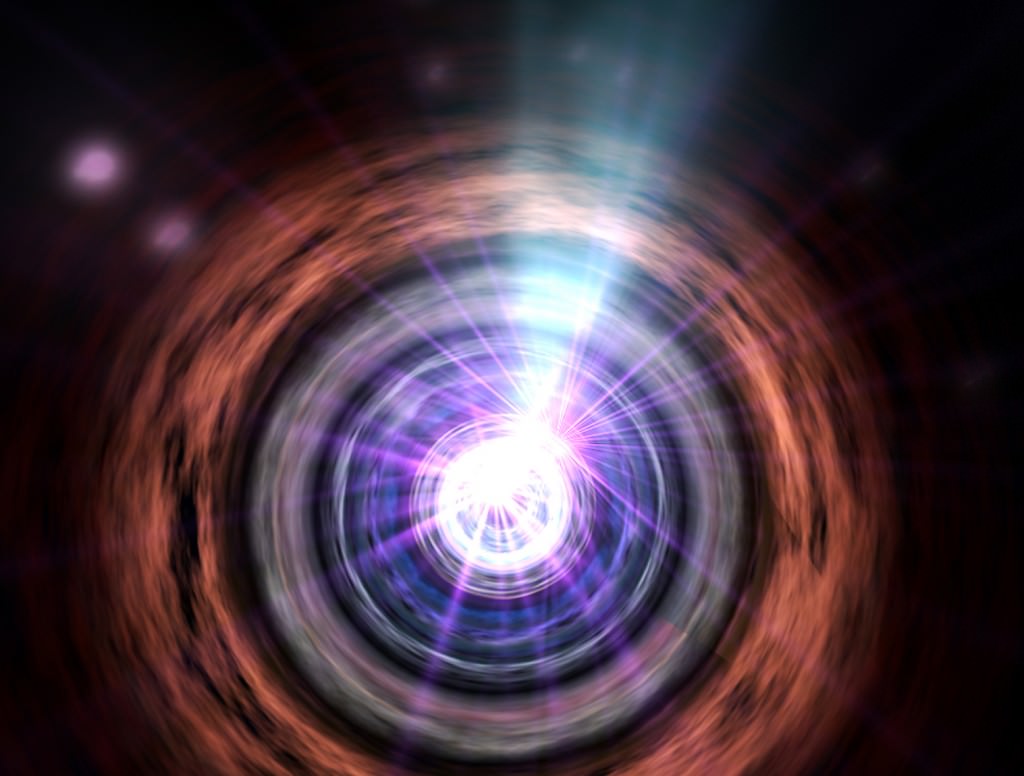
Two scientists at Italy’s National Institute of Nuclear Physics, Mario Nicola Mazziotta and Francesco Loparco, have been studying the Moon’s gamma radiation as a means to understand cosmic rays. Cosmic rays are fast-moving particles, and they gain their acceleration from their sources, like the aforementioned supernovae and AGN.
“Cosmic rays are mostly protons accelerated by some of the most energetic phenomena in the universe, like the blast waves of exploding stars and jets produced when matter falls into black holes,” explained Mazziotta in a NASA press release.
The particles that make up cosmic rays are electrically charged. When they strike a magnetic field, like the Earth’s magnetosphere, they’re mostly deflected. But the Moon lacks a magnetic field. As a result, even the weakest cosmic rays strike the Moon’s surface directly, and that produces gamma rays. The Moon actually absorbs most of the gamma rays it creates, but some escape out into space.
And the Fermi Telescope can see them, turning the Moon into a kind of inadvertent particle detector.
The Fermi Gamma-Ray Space Telescope (FGRST) has been at work for 11 years now. Mazziotta and Loparco have studied images of the Moon from the length of the telescope’s mission, and over that time, the view has improved.
“… the Moon would never go through its monthly cycle of phases and would always look full.”
Francesco Loparco, Italy’s National Institute of Nuclear Physics.
The strength of the Moon’s gamma rays is not always consistent. It varies over time. Mazziotta and Loparco gathered together data of the Moon’s gamma rays that exceeded 31 million electron volts, which is 10 million times more powerful than visible light, and organized them over time. That resulted in the following image, which shows the view improving over time.
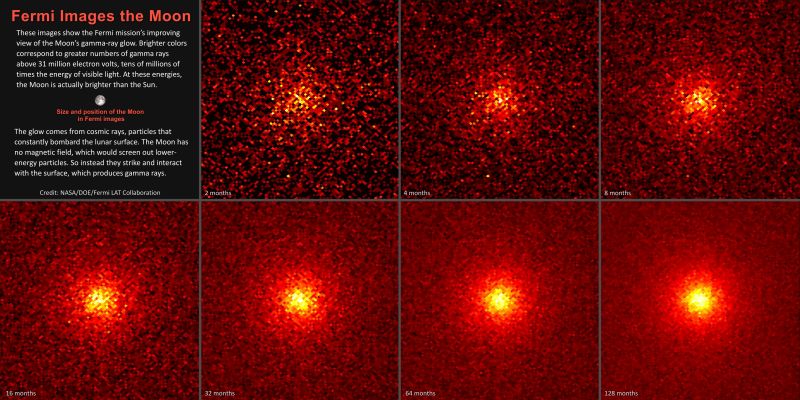
Credit: NASA/DOE/Fermi LAT Collaboration
“Seen at these energies, the Moon would never go through its monthly cycle of phases and would always look full,” said Loparco.
The fact that the Moon emits these gamma rays is cautionary. NASA’s Artemis Program will see more astronauts on the Moon for potentially longer periods of time than other Moon missions. They’ll have to be protected from both the cosmic rays that strike the Moon, and the Moon’s gamma rays that result.
A Complex Interaction
The interplay between cosmic rays, gamma rays, the Moon and the Sun can be complex. Gamma rays can have different energy levels. For instance, these FGRST images only capture gamma rays that exceeded 31 million electron volts (MeV) by a certain amount. But gamma rays can be far more energetic than that, and can be in the billions or even trillions of MeVs.
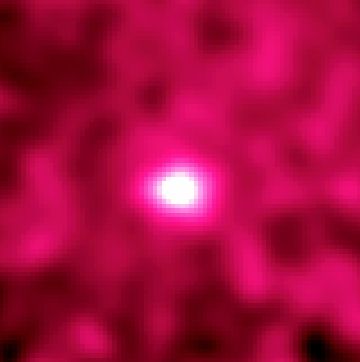
Since the electrical charge of cosmic rays means they can be deflected by magnetic fields, and the Sun has a powerful magnetic field, only the most powerful ones can strike the Sun. In turn, these powerful cosmic rays strike the dense part of the Sun’s atmosphere and create very powerful gamma rays. So the Sun is actually brighter in gamma rays above 1 billion electron volts than the Moon is.
The Sun’s 11-year cycle also affects the cosmic rays that strike the Moon, and the gamma rays that result. During that cycle, the Sun experiences variations in its magnetic field. As a result, sometimes more cosmic rays strike the Moon than other times. This variability in cosmic rays striking the lunar surface creates a variability in lunar gamma rays. According to Fermi data, it can vary by 20%.

Gamma rays coming from the Moon, and the cosmic rays that cause them, both pose a threat to astronauts because both are ionizing radiation with great penetrating power. It takes a lot of shielding to prevent them from striking astronauts. Materials with high atomic numbers are effective shields. Lead (atomic number 82) is a good shield because it’s also very dense.
For lower energy gamma rays, the risk to astronauts is due to exposure over time. Think of an x-ray technician vs. an x-ray patient. A patient’s lifetime exposure to x-rays is not very high, so a patient accepts the risk. For the technician however, things are different. They’re exposed each work day, so they leave the room and are shielded from the x-rays by materials like lead.
It’s similar for astronauts. The more time they spend on the Moon in a gamma ray/cosmic ray environment, the more they need to limit their exposure. Not only by shielding, but by timing.
Trying to Understand the Moon’s Radiation Environment
This Fermi Gamma-Ray Space Telescope data is helping scientists understand the gamma ray/cosmic ray risk on the Moon. If there are times when the Moon emits 20% less gamma radiation because of the Sun’s 11-year cycle, then it may be sensible to make use of that time.
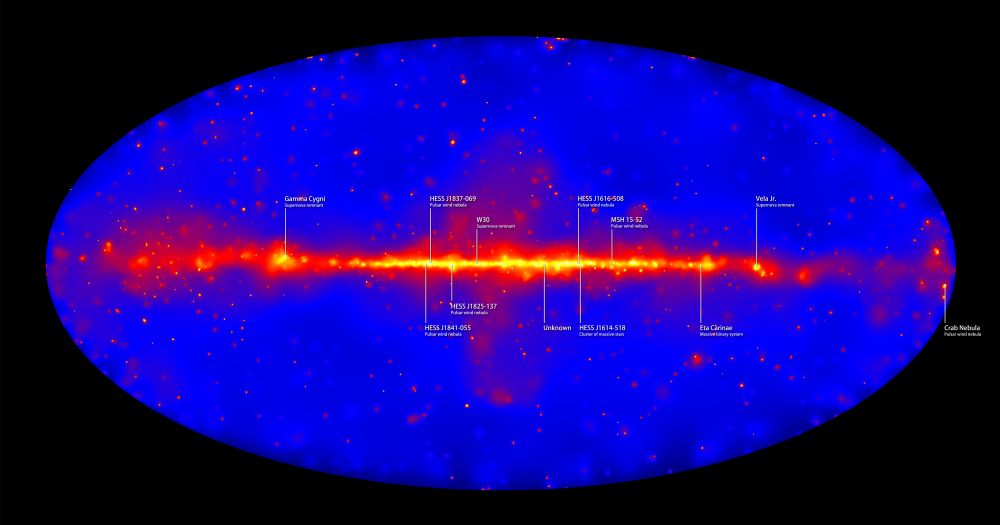
Exposure to radiation is one of the main barriers to space travel and long-term space missions. Earth’s magnetosphere and atmosphere are both radiation shields. But even in Low-Earth Orbit, astronauts risk exposure to greater radiation.
If we’re going to have a human presence on the Moon, it’s imperative that we understand the radiation environment there. NASA has been looking into the lunar radiation environment as far back as 2005 in anticipation of a human outpost on the Moon. When they launched the Lunar Reconnaissance Orbiter (LRO) in 2009, it contained an instrument called the Cosmic Ray Telescope for the Effects of Radiation (CRaTER).
CRaTER’s job is to characterize the Moon’s radiation environment and the biological impact it will have on astronauts. It uses plastics to mimic human tissue and placed them behind different shielding materials. At the time, Harlan Spence, the Principal Investigator CRaTER said, “Not only will we measure the radiation, we will use plastics that mimic human tissue to look at how these highly energetic particles penetrate and interact with the human body.”
The Fermi images of the Moon’s gamma rays are another piece of the radiation puzzle. And that’s a puzzle that has to be solved before there’s a realistic hope of a long-term lunar base, or crewed missions to Mars.
More:
- Press Release: Moon Glows Brighter Than Sun in Images From NASA’s Fermi
- NASA: Fermi Gamma-Ray Space Telescope
- NASA: Tour of the Electromagnetic Spectrum: Gamma Rays
- Press Release: NASA’s Fermi Space Telescope Sharpens its High-energy Vision
- Press Release: Understanding the Magnetic Sun
- NASA: The Radioactive Moon

